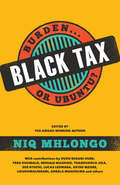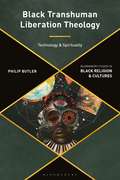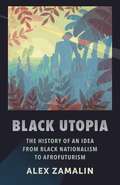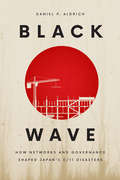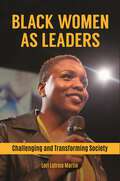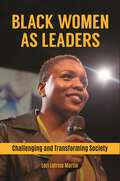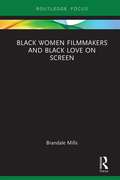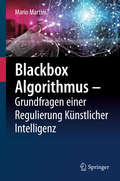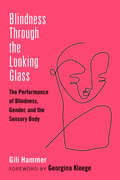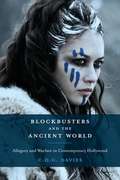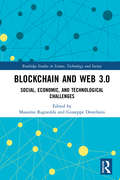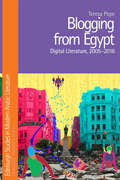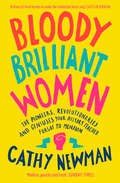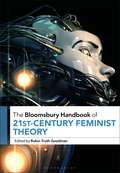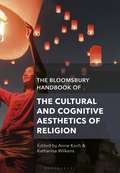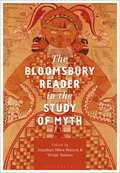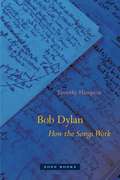- Table View
- List View
Black Tax: Burden or Ubuntu?
by Niq Mhlongo‘The real significance of this book lies in the fact that it tells us more about the everyday life of black South Africans. It delves into the essence of black family life and the secret anguish of family members who often battle to cope.’ – Niq MhlongoA secret torment for some, a proud responsibility for others, ‘black tax’ is a daily reality for thousands of black South Africans. In this thought-provoking and moving anthology, a provocative range of voices share their deeply personal stories.With the majority of black South Africans still living in poverty today, many black middle-class households are connected to working-class or jobless homes. Some believe supporting family members is an undeniable part of African culture and question whether it should even be labelled as a kind of tax.Others point to the financial pressure it places on black students and professionals, who, as a consequence, struggle to build their own wealth. Many feel they are taking over what is essentially a government responsibility.The contributions also investigate the historical roots of black tax, the concept of the black family and the black middle class.In giving voice to so many different perspectives, Black Tax hopes to start a dialogue on this widespread social phenomenon.
Black Transhuman Liberation Theology: Technology and Spirituality (Bloomsbury Studies in Black Religion and Cultures)
by Philip ButlerMediating Black religious studies, spirituality studies, and liberation theology, Philip Butler explores what might happen if Black people in the United States merged technology and spirituality in their fight towards materializing liberating realities. The discussions shaping what it means for humans to exist with technology and as part of technology are already underway: transhumanism suggests that any use of technology to augment intellectual, psychological, or physical capability makes one transhuman. In an attempt to encourage Black people in the United States to become technological progenitors as a spiritual act, Butler asks whether anyone has ever been 'just' human? Butler then explores the implications of this question and its link to viewing the body as technology. Re-imagining incarnation as a relationship between vitality, biochemistry, and genetics, the book also takes a critical scientific approach to understanding the biological embodiment of Black spiritual practices. It shows how current and emerging technologies might align with the generative biological states of Black spiritualities in order to concretely disrupt and dismantle oppressive societal structures.
Black Utopia: The History Of An Idea From Black Nationalism To Afrofuturism (PDF)
by Alex ZamalinWithin the history of African American struggle against racist oppression that often verges on dystopia, a hidden tradition has depicted a transfigured world. Daring to speculate on a future beyond white supremacy, black utopian artists and thinkers offer powerful visions of ways of being that are built on radical concepts of justice and freedom. They imagine a new black citizen who would inhabit a world that soars above all existing notions of the possible. In Black Utopia, Alex Zamalin offers a groundbreaking examination of African American visions of social transformation and their counterutopian counterparts. Considering figures associated with racial separatism, postracialism, anticolonialism, Pan-Africanism, and Afrofuturism, he argues that the black utopian tradition continues to challenge American political thought and culture. Black Utopia spans black nationalist visions of an ideal Africa, the fiction of W. E. B. Du Bois, and Sun Ra's cosmic mythology of alien abduction. Zamalin casts Samuel R. Delany and Octavia E. Butler as political theorists and reflects on the antiutopian challenges of George S. Schuyler and Richard Wright. Their thought proves that utopianism, rather than being politically immature or dangerous, can invigorate political imagination. Both an inspiring intellectual history and a critique of present power relations, this book suggests that, with democracy under siege across the globe, the black utopian tradition may be our best hope for combating injustice.
Black Wave: How Networks and Governance Shaped Japan’s 3/11 Disasters
by Daniel P. AldrichDespite the devastation caused by the magnitude 9.0 earthquake and 60-foot tsunami that struck Japan in 2011, some 96% of those living and working in the most disaster-stricken region of Tōhoku made it through. Smaller earthquakes and tsunamis have killed far more people in nearby China and India. What accounts for the exceptionally high survival rate? And why is it that some towns and cities in the Tōhoku region have built back more quickly than others? Black Wave illuminates two critical factors that had a direct influence on why survival rates varied so much across the Tōhoku region following the 3/11 disasters and why the rebuilding process has also not moved in lockstep across the region. Individuals and communities with stronger networks and better governance, Daniel P. Aldrich shows, had higher survival rates and accelerated recoveries. Less-connected communities with fewer such ties faced harder recovery processes and lower survival rates. Beyond the individual and neighborhood levels of survival and recovery, the rebuilding process has varied greatly, as some towns and cities have sought to work independently on rebuilding plans, ignoring recommendations from the national government and moving quickly to institute their own visions, while others have followed the guidelines offered by Tokyo-based bureaucrats for economic development and rebuilding.
Black Wave: How Networks and Governance Shaped Japan’s 3/11 Disasters
by Daniel P. AldrichDespite the devastation caused by the magnitude 9.0 earthquake and 60-foot tsunami that struck Japan in 2011, some 96% of those living and working in the most disaster-stricken region of Tōhoku made it through. Smaller earthquakes and tsunamis have killed far more people in nearby China and India. What accounts for the exceptionally high survival rate? And why is it that some towns and cities in the Tōhoku region have built back more quickly than others? Black Wave illuminates two critical factors that had a direct influence on why survival rates varied so much across the Tōhoku region following the 3/11 disasters and why the rebuilding process has also not moved in lockstep across the region. Individuals and communities with stronger networks and better governance, Daniel P. Aldrich shows, had higher survival rates and accelerated recoveries. Less-connected communities with fewer such ties faced harder recovery processes and lower survival rates. Beyond the individual and neighborhood levels of survival and recovery, the rebuilding process has varied greatly, as some towns and cities have sought to work independently on rebuilding plans, ignoring recommendations from the national government and moving quickly to institute their own visions, while others have followed the guidelines offered by Tokyo-based bureaucrats for economic development and rebuilding.
Black Wave: How Networks and Governance Shaped Japan’s 3/11 Disasters
by Daniel P. AldrichDespite the devastation caused by the magnitude 9.0 earthquake and 60-foot tsunami that struck Japan in 2011, some 96% of those living and working in the most disaster-stricken region of Tōhoku made it through. Smaller earthquakes and tsunamis have killed far more people in nearby China and India. What accounts for the exceptionally high survival rate? And why is it that some towns and cities in the Tōhoku region have built back more quickly than others? Black Wave illuminates two critical factors that had a direct influence on why survival rates varied so much across the Tōhoku region following the 3/11 disasters and why the rebuilding process has also not moved in lockstep across the region. Individuals and communities with stronger networks and better governance, Daniel P. Aldrich shows, had higher survival rates and accelerated recoveries. Less-connected communities with fewer such ties faced harder recovery processes and lower survival rates. Beyond the individual and neighborhood levels of survival and recovery, the rebuilding process has varied greatly, as some towns and cities have sought to work independently on rebuilding plans, ignoring recommendations from the national government and moving quickly to institute their own visions, while others have followed the guidelines offered by Tokyo-based bureaucrats for economic development and rebuilding.
Black Wave: How Networks and Governance Shaped Japan’s 3/11 Disasters
by Daniel P. AldrichDespite the devastation caused by the magnitude 9.0 earthquake and 60-foot tsunami that struck Japan in 2011, some 96% of those living and working in the most disaster-stricken region of Tōhoku made it through. Smaller earthquakes and tsunamis have killed far more people in nearby China and India. What accounts for the exceptionally high survival rate? And why is it that some towns and cities in the Tōhoku region have built back more quickly than others? Black Wave illuminates two critical factors that had a direct influence on why survival rates varied so much across the Tōhoku region following the 3/11 disasters and why the rebuilding process has also not moved in lockstep across the region. Individuals and communities with stronger networks and better governance, Daniel P. Aldrich shows, had higher survival rates and accelerated recoveries. Less-connected communities with fewer such ties faced harder recovery processes and lower survival rates. Beyond the individual and neighborhood levels of survival and recovery, the rebuilding process has varied greatly, as some towns and cities have sought to work independently on rebuilding plans, ignoring recommendations from the national government and moving quickly to institute their own visions, while others have followed the guidelines offered by Tokyo-based bureaucrats for economic development and rebuilding.
Black Wave: How Networks and Governance Shaped Japan’s 3/11 Disasters
by Daniel P. AldrichDespite the devastation caused by the magnitude 9.0 earthquake and 60-foot tsunami that struck Japan in 2011, some 96% of those living and working in the most disaster-stricken region of Tōhoku made it through. Smaller earthquakes and tsunamis have killed far more people in nearby China and India. What accounts for the exceptionally high survival rate? And why is it that some towns and cities in the Tōhoku region have built back more quickly than others? Black Wave illuminates two critical factors that had a direct influence on why survival rates varied so much across the Tōhoku region following the 3/11 disasters and why the rebuilding process has also not moved in lockstep across the region. Individuals and communities with stronger networks and better governance, Daniel P. Aldrich shows, had higher survival rates and accelerated recoveries. Less-connected communities with fewer such ties faced harder recovery processes and lower survival rates. Beyond the individual and neighborhood levels of survival and recovery, the rebuilding process has varied greatly, as some towns and cities have sought to work independently on rebuilding plans, ignoring recommendations from the national government and moving quickly to institute their own visions, while others have followed the guidelines offered by Tokyo-based bureaucrats for economic development and rebuilding.
Black Wave: How Networks and Governance Shaped Japan’s 3/11 Disasters
by Daniel P. AldrichDespite the devastation caused by the magnitude 9.0 earthquake and 60-foot tsunami that struck Japan in 2011, some 96% of those living and working in the most disaster-stricken region of Tōhoku made it through. Smaller earthquakes and tsunamis have killed far more people in nearby China and India. What accounts for the exceptionally high survival rate? And why is it that some towns and cities in the Tōhoku region have built back more quickly than others? Black Wave illuminates two critical factors that had a direct influence on why survival rates varied so much across the Tōhoku region following the 3/11 disasters and why the rebuilding process has also not moved in lockstep across the region. Individuals and communities with stronger networks and better governance, Daniel P. Aldrich shows, had higher survival rates and accelerated recoveries. Less-connected communities with fewer such ties faced harder recovery processes and lower survival rates. Beyond the individual and neighborhood levels of survival and recovery, the rebuilding process has varied greatly, as some towns and cities have sought to work independently on rebuilding plans, ignoring recommendations from the national government and moving quickly to institute their own visions, while others have followed the guidelines offered by Tokyo-based bureaucrats for economic development and rebuilding.
Black Women as Leaders: Challenging and Transforming Society
by Lori Latrice MartinThis book examines how black women have identified challenges in major social institutions across history and demonstrated adaptive leadership in mobilizing people to tackle those challenges facing black communities.Most studies about black women and social justice issues focus on the responses of black women to racism within the context of the feminist movement and/or the responses of black women to sexism in black liberation movements. Such discussions often fail to explore the ways in which black women's commitment to negotiating their racial, gender, and class identities, while engaged in the practice of leadership, is discouraged and ignored. Black Women as Leaders analyzes the commitment of contemporary black women to social justice issues from the perspective of adaptive leadership. It shows how black women are often forced into the public practice of leadership due to violent attacks from people with whom they are in engaged in interpersonal relationships. The book also breaks new ground by revealing how black women suffer from the devaluation and vilification of their engagement in the practice of leadership in private settings, such as their homes and selected religious and institutional settings.
Black Women as Leaders: Challenging and Transforming Society
by Lori Latrice MartinThis book examines how black women have identified challenges in major social institutions across history and demonstrated adaptive leadership in mobilizing people to tackle those challenges facing black communities.Most studies about black women and social justice issues focus on the responses of black women to racism within the context of the feminist movement and/or the responses of black women to sexism in black liberation movements. Such discussions often fail to explore the ways in which black women's commitment to negotiating their racial, gender, and class identities, while engaged in the practice of leadership, is discouraged and ignored. Black Women as Leaders analyzes the commitment of contemporary black women to social justice issues from the perspective of adaptive leadership. It shows how black women are often forced into the public practice of leadership due to violent attacks from people with whom they are in engaged in interpersonal relationships. The book also breaks new ground by revealing how black women suffer from the devaluation and vilification of their engagement in the practice of leadership in private settings, such as their homes and selected religious and institutional settings.
Black Women Filmmakers and Black Love on Screen (Routledge Transformations in Race and Media)
by Brandale N. MillsThis book offers a thorough analysis of how romantic love between Black men and women (referred to here as Black Love) is portrayed in Hollywood films, specifically from the perspective of Black female filmmakers. Using historical and contemporary images of Black female representation in the media as a foundation, the main themes of this text focus on the male gazes’ influence on Hollywood narratives, the necessity for the Black female perspective in Hollywood, and that perspective’s influence on ideologies and narratives.
Black Women Filmmakers and Black Love on Screen (Routledge Transformations in Race and Media)
by Brandale N. MillsThis book offers a thorough analysis of how romantic love between Black men and women (referred to here as Black Love) is portrayed in Hollywood films, specifically from the perspective of Black female filmmakers. Using historical and contemporary images of Black female representation in the media as a foundation, the main themes of this text focus on the male gazes’ influence on Hollywood narratives, the necessity for the Black female perspective in Hollywood, and that perspective’s influence on ideologies and narratives.
Blackbox Algorithmus – Grundfragen einer Regulierung Künstlicher Intelligenz
by Mario MartiniDieses Buch liefert eine rechtswissenschaftliche Analyse der Chancen und Gefahren algorithmenbasierter Verfahren. Algorithmen, die im Maschinenraum moderner Softwareanwendungen werkeln, sind zu zentralen Steuerungsinstanzen der digitalen Gesellschaft avanciert. Immer nachhaltiger beeinflussen sie unser Leben. Ihre Funktionsweise gleicht aber teilweise einer Blackbox. Die in ihr schlummernden Risiken zu bändigen, fordert die Rechtsordnung heraus. Das Buch beleuchtet die gesellschaftlichen Gefahren einer zunehmenden gesellschaftlichen Steuerung durch Algorithmen und entwickelt erste Regulierungsideen, mit deren Hilfe sich die Wertschöpfungspotenziale automatisierter digitaler Prozesse mit den Grundwerten der Rechtsordnung versöhnen lassen.
Blindness Through the Looking Glass: The Performance of Blindness, Gender, and the Sensory Body (Corporealities: Discourses Of Disability)
by Gili HammerModern Western culture is saturated with images, imprinting visual standards of concepts such as beauty and femininity onto our collective consciousness. Blindness Through the Looking Glass examines how gender and femininity are performed and experienced in everyday life by women who do not rely on sight as their dominant mode of perception, identifying the multiple senses involved in the formation of gender identity within social interactions. Challenging visuality as the dominant mode to understand gender, social performance, and visual culture, the book offers an ethnographic investigation of blindness (and sight) as a human condition, putting both blindness and vision “on display” by discussing people’s auditory, tactile, and olfactory experiences as well as vision and sight, and by exploring ways that individuals perform blindness and “sightedness” in their everyday lives. Based on in-depth interviews with 40 blind women in Israel and anthropological fieldwork, the book investigates the social construction and daily experience of blindness in a range of domains. Uniquely, the book brings together blind symbolism with the everyday experiences of blind and sighted individuals, joining in mutual conversation the fields of disability studies, visual culture, anthropology of the senses, and gender studies.
Blockbusters and the Ancient World: Allegory and Warfare in Contemporary Hollywood
by Chris DaviesFollowing the release of Ridley Scott's Gladiator in 2000 the ancient world epic has experienced a revival in studio and audience interest. Building on existing scholarship on the Cold War epics of the 1950s-60s, including Ben-Hur, Spartacus and The Robe, this original study explores the current cycle of ancient world epics in cinema within the social and political climate created by September 11th 2001. Examining films produced against the backdrop of the War on Terror and subsequent invasions of Iraq and Afghanistan, this book assesses the relationship between mainstream cinema and American society through depictions of the ancient world, conflict and faith. Davies explores how these films evoke depictions of WWII, the Vietnam War and the Western in portraying warfare in the ancient world, as well discussing the influence of genre hybridisation, narration and reception theory. He questions the extent to which ancient world epics utilise allegory, analogy and allusion to parallel past and present in an industry often dictated by market forces. Featuring analysis of Alexander, Troy, 300, Centurion, The Eagle, The Passion of the Christ and more, this book offers new insight on the continued evolution of the ancient world epic in cinema.
Blockchain and Web 3.0: Social, Economic, and Technological Challenges (Routledge Studies in Science, Technology and Society)
by Massimo Ragnedda Giuseppe DestefanisBlockchain is no longer just about bitcoin or cryptocurrencies in general. Instead, it can be seen as a disruptive, revolutionary technology which will have major impacts on multiple aspects of our lives. The revolutionary power of such technology compares with the revolution sparked by the World Wide Web and the Internet in general. Just as the Internet is a means of sharing information, so blockchain technologies can be seen as a way to introduce the next level: sharing value. Blockchain and Web 3.0 fills the gap in our understanding of blockchain technologies by hosting a discussion of the new technologies in a variety of disciplinary settings. Indeed, this volume explains how such technologies are disruptive and comparatively examines the social, economic, technological and legal consequences of these disruptions. Such a comparative perspective has previously been underemphasized in the debate about blockchain, which has subsequently led to weaknesses in our understanding of decentralized technologies. Underlining the risks and opportunities offered by the advent of blockchain technologies and the rise of Web 3.0, Blockchain and Web 3.0 will appeal to researchers and academics interested in fields such as sociology and social policy, cyberculture, new media and privacy and data protection.
Blockchain and Web 3.0: Social, Economic, and Technological Challenges (Routledge Studies in Science, Technology and Society)
by Massimo Ragnedda Giuseppe DestefanisBlockchain is no longer just about bitcoin or cryptocurrencies in general. Instead, it can be seen as a disruptive, revolutionary technology which will have major impacts on multiple aspects of our lives. The revolutionary power of such technology compares with the revolution sparked by the World Wide Web and the Internet in general. Just as the Internet is a means of sharing information, so blockchain technologies can be seen as a way to introduce the next level: sharing value. Blockchain and Web 3.0 fills the gap in our understanding of blockchain technologies by hosting a discussion of the new technologies in a variety of disciplinary settings. Indeed, this volume explains how such technologies are disruptive and comparatively examines the social, economic, technological and legal consequences of these disruptions. Such a comparative perspective has previously been underemphasized in the debate about blockchain, which has subsequently led to weaknesses in our understanding of decentralized technologies. Underlining the risks and opportunities offered by the advent of blockchain technologies and the rise of Web 3.0, Blockchain and Web 3.0 will appeal to researchers and academics interested in fields such as sociology and social policy, cyberculture, new media and privacy and data protection.
Blogging from Egypt: Digital Literature, 2005-2016 (Edinburgh Studies in Modern Arabic Literature)
by Teresa PepeSix years before the Egyptian revolution of January 2011, many young Egyptians had resorted to blogging as a means of self-expression and literary creativity. This resulted in the emergence of a new literary genre: the autofictional blog. Such blogs are explored here as forms of digital literature, combining literary analysis and interviews with the authors. The blogs analysed give readers a glimpse into the daily lives, feelings and aspirations of the Egyptian youth who have pushed the country towards a cultural and political revolution. The narratives are also indicative of significant aesthetic and political developments taking place in Arabic literature and culture.
Bloody Brilliant Women: Pioneers, Revolutionaries And Geniuses Your History Teacher Forgot To Mention
by Cathy Newman‘A litany of fresh heroes to make the embattled heart sing’ Caitlin Moran ‘Newman is a brilliant writer’ Observer A fresh, opinionated history of all the brilliant women you should have learned about in school but didn’t.
The Bloomsbury Handbook of 21st-Century Feminist Theory
by Robin Truth GoodmanThe Bloomsbury Handbook of 21st-Century Feminist Theory is the most comprehensive available survey of the state of the art of contemporary feminist thought. With chapters written by world-leading scholars from a range of disciplines, the book explores the latest thinking on key topics in current feminist discourse, including: · Feminist subjectivity – from identity, difference, and intersectionality to affect, sex and the body · Feminist texts – writing, reading, genre and critique · Feminism and the world – from power, trauma and value to technology, migration and community Including insights from literary and cultural studies, philosophy, political science and sociology, The Bloomsbury Handbook of 21st-Century Feminist Theory is an essential overview of current feminist thinking and future directions for scholarship, debate and activism.
The Bloomsbury Handbook of the Cultural and Cognitive Aesthetics of Religion (Bloomsbury Handbooks)
by Edited by Anne Koch Katharina WilkensBridging the gap between cognition and culture, this handbook explores both social scientific and humanities approaches to understanding the physical processes of religious life, tradition, practice, and belief. It reflects the cultural turn within the study of religion and puts theory to the fore, moving beyond traditional theological, philosophical, and ethnographic understandings of the aesthetics of religion.Editors Anne Koch and Katharina Wilkens bring together research in cultural studies, cognitive studies, material religion, religion and the arts, and epistemology. Questions of identity, gender, ethnicity, and postcolonialism are discussed throughout. Key topics include materiality, embodiment, performance, popular/vernacular art and space to move beyond a sensory understanding of aesthetics. Emerging areas of research are covered, including secular aesthetics and the aesthetic of spirits.This is an important contribution to theory and method in the study of religion, and is grounded in research that has been taking place in Europe over the past 20 years. Case studies are drawn from around the world with contributions from scholars based in Europe, the USA, and Australia. The book is illustrated with over 40 color images and features a foreword from Birgit Meyer.
The Bloomsbury Reader in the Study of Myth
by Jonathan Miles-Watson Vivian AsimosWhat is myth? Why do myths exist? What do myths do? Where are myths going? This reader is organized into 4 parts which explore these questions. Drawing on over 10 years of experience teaching myth in religious studies and anthropology departments in the UK, USA and Continental Europe the editors have brought together key works in the theory of myth. Key features include: - a general introduction to the reader that outlines a comparative and interpretative framework - an introduction contextualizing each part and sub-section - an introduction to each reading by the editors - a companion website that provides discussion questions and further reading suggestions, including primary sources. From functionalism to feminism, nationalism to globalization, and psychoanalysis to spatial analysis, this reader covers the classic and contemporary theories and approaches needed to understand what myth is, why myths exist, what they do, and what the future holds for them.
Bob Dylan: How the Songs Work
by Timothy HamptonA career-spanning account of the artistry and politics of Bob Dylan’s songwritingBob Dylan’s reception of the 2016 Nobel Prize for Literature has elevated him beyond the world of popular music, establishing him as a major modern artist. However, until now, no study of his career has focused on the details and nuances of the songs, showing how they work as artistic statements designed to create meaning and elicit emotion. Bob Dylan: How the Songs Work (originally published as Bob Dylan's Poetics) is the first comprehensive book on both the poetics and politics of Dylan’s compositions. It studies Dylan, not as a pop hero, but as an artist, as a maker of songs. Focusing on the interplay of music and lyric, it traces Dylan’s innovative use of musical form, his complex manipulation of poetic diction, and his dialogues with other artists, from Woody Guthrie to Arthur Rimbaud. Moving from Dylan’s earliest experiments with the blues, through his mastery of rock and country, up to his densely allusive recent recordings, Timothy Hampton offers a detailed account of Dylan’s achievement. Locating Dylan in the long history of artistic modernism, the book studies the relationship between form, genre, and the political and social themes that crisscross Dylan’s work. Bob Dylan: How the Songs Work offers both a nuanced engagement with the work of a major artist and a meditation on the contribution of song at times of political and social change.
Bob Dylan: How the Songs Work
by Timothy HamptonA career-spanning account of the artistry and politics of Bob Dylan’s songwritingBob Dylan’s reception of the 2016 Nobel Prize for Literature has elevated him beyond the world of popular music, establishing him as a major modern artist. However, until now, no study of his career has focused on the details and nuances of the songs, showing how they work as artistic statements designed to create meaning and elicit emotion. Bob Dylan: How the Songs Work (originally published as Bob Dylan's Poetics) is the first comprehensive book on both the poetics and politics of Dylan’s compositions. It studies Dylan, not as a pop hero, but as an artist, as a maker of songs. Focusing on the interplay of music and lyric, it traces Dylan’s innovative use of musical form, his complex manipulation of poetic diction, and his dialogues with other artists, from Woody Guthrie to Arthur Rimbaud. Moving from Dylan’s earliest experiments with the blues, through his mastery of rock and country, up to his densely allusive recent recordings, Timothy Hampton offers a detailed account of Dylan’s achievement. Locating Dylan in the long history of artistic modernism, the book studies the relationship between form, genre, and the political and social themes that crisscross Dylan’s work. Bob Dylan: How the Songs Work offers both a nuanced engagement with the work of a major artist and a meditation on the contribution of song at times of political and social change.
